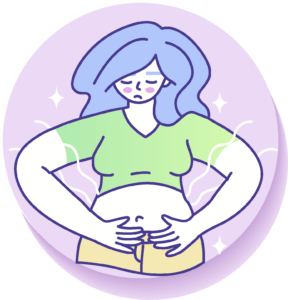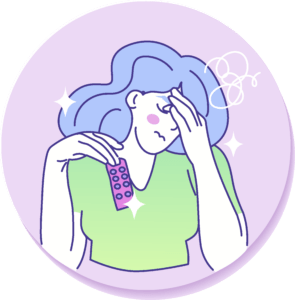
Have you ever felt that struggle in the days or weeks leading up to your menstrual cycle that makes you feel like your whole world is upside down? That’s called PMS (premenstrual syndrome), and it’s super common – like, millions of women experience it every month common.
In rare cases, women can experience a more severe and debilitating version of PMS called PMDD (Premenstrual Dysphoric Disorder). We will delve into everything you need to know about PMS and PMDD, including its symptoms, causes, and possible relief options.
PMS, or premenstrual syndrome, is a common term used to describe a combination of physical, emotional, and behavioral symptoms that many women experience in the days or weeks leading up to their menstrual period. The exact cause of PMS is not fully understood, but hormonal fluctuations can play a significant role. Changes in hormone levels, particularly estrogen and progesterone, can trigger these symptoms. While PMS is a natural part of the menstrual cycle for many women, its severity can vary.
Premenstrual Dysphoric Disorder (PMDD) is a severe and relatively rare form of premenstrual syndrome (PMS). It is characterized by extreme and debilitating physical, emotional, and psychological symptoms that occur in the luteal phase of the menstrual cycle, typically in the two weeks before menstruation. PMDD is more intense and disruptive than regular PMS. Experts aren’t sure what causes PMDD or why only about 5% of women develop it. But many believe it’s related to hormones and neurotransmitters (the brain’s chemical messengers).
The symptoms of PMS can vary from person to person but often include:
PMDD is more intense and disruptive than regular PMS and is characterized by extreme and debilitating symptoms that can significantly affect a person’s quality of life and daily functioning.
Common symptoms of PMDD can include:
 Physical Symptoms: This can include severe back pain, bloating, acne, breast tenderness, hot flashes, and headaches.
Physical Symptoms: This can include severe back pain, bloating, acne, breast tenderness, hot flashes, and headaches.Managing PMS and PMDD can be challenging, but some various strategies and treatments can help alleviate the symptoms. What works for some individuals may not work for everyone. It’s always best to speak to a healthcare provider. Here are some general tips:
If you suspect you are experiencing PMDD, first, ask yourself how your symptoms impact your life. Are you missing work, missing school or unable to socialize? If yes, tell your healthcare provider because it may be PMDD.
During your visit, they may conduct blood tests to check for any deficiencies or issues that may have similar symptoms to PMDD. They may also ask about your medical history, including any previous experiences with anxiety or depression. There is no treatment that works for everyone, but some options that your doctor may bring up are:
Understanding the challenges and differences between PMS and PMDD is essential for women’s well-being.
If you or someone you know is experiencing these symptoms, remember that various strategies and treatments are available. It’s important to consult with a healthcare provider to create a personalized plan to help alleviate these conditions’ physical, emotional, and psychological symptoms. With the proper support and information, managing and improving your quality of life during these challenging times is possible.
© A Step Ahead Chattanooga 2024 and website designed by Brightside Creates.
We collect cookies to analyze our website traffic and performance; we never share any personal data. View our Privacy Policy.